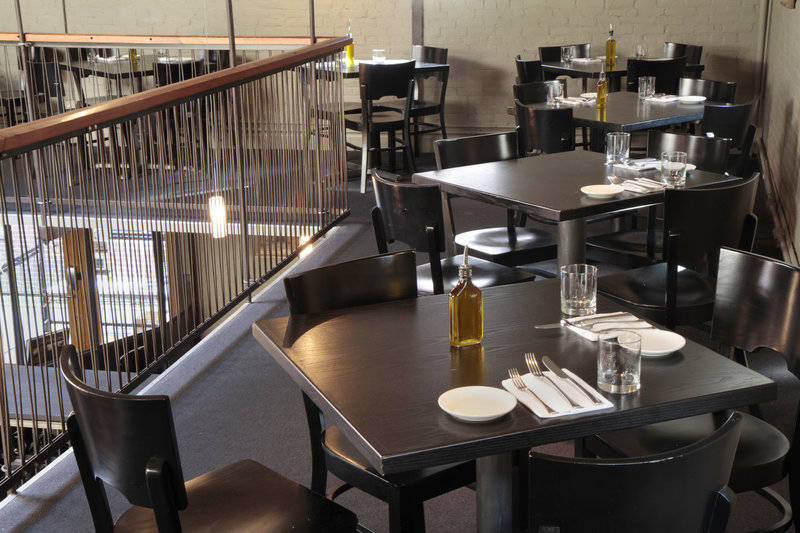New dining establishments in Greater Portland tend to draw much attention, which can mean that established restaurants — those that helped to foster the city’s reputation for great food — sometimes get taken for granted.
Cinque Terre may be one such place, recognized over the years in regional and national media for its commitment to using local produce and seafood. The restaurant has been part of the city’s haute cuisine infrastructure for more than a decade.
Executive chef and co-owner Lee Skawinski draws his inspiration from Italy, particularly the Liguria coast, where five villages interconnect. At Cinque Terre, farm-to-table is more than a trendy phrase. Annually, Skawinski gets 40 percent of his produce from his co-owners’ property, Grand View Farm in Greene. In the summer, that percentage is 50 to 60. His menu changes daily to reflect what’s fresh at the fishmonger or farm.
In addition, the chef and his staff travel to Italy every year to visit producers and vintners to select the best products and libations. This care merging ingredients from Maine and the Old World transfers to the plate, and the result is cuisine that is outstanding yet unfussy.
On the night we visited, 11 antipasti options included Italian inspired variations on salads, mussels, calamari, oysters, minestrone. Our mista of leaf lettuce, pickled ramps, beets, and radishes with a Trebbiano white wine vinaigrette ($10) presented spring produce at its best; a soft sphere of breaded and lightly fried goat cheese added a luscious grace note. Sous vide artichokes were al dente and flavor rich, offsetting a soft burrata cheese (buffalo mozzarella enveloping an interior of cream and additional mozzarella), marinated tomatoes, and basil ($12).
As for primi, house-cured lamb pancetta served with an egg, roasted garlic, and cream sauce over fettucini had a lovely earthiness ($12/18). Trenette came with three enormous gulf shrimp, olives, sundried tomatoes, basil and potatoes (we chose small for $14; large size is $21), a pleasing Mediterranean meld. A simple rigatoni with tomato ragu and mozzarella sparkled with depth, a sweet and strong balsamic lending a vibrant kick ($12/18). The restaurant’s primi courses, even the smaller size, can easily be a quality main meal for diners. Pair a bowl of hand-cut pasta with a glass of Italian wine to satisfy your palate and budget.
But it’s hard to ignore the chef’s tempting secondi. Maine diver scallops, giant-size and perfectly pan-seared to a gentle texture, came on top of herbed lentils, giving the dish a countryside heft ($25). Grilled local asparagus, tomatoes, olives, and balsamic aioli accompanied this superb entree.
Moist, grilled swordfish served over Italian messicucia (a mix of cannelloni beans and farro cooked in white wine and olive oil; this one had a peppery bite) was another fully satisfying and peasant-y plate ($23). Alto Adige speck, a lightly smoked ham, added depth and cohesion to coin-sized, roasted rabbit loins that were taut, mild and tasty ($22).
In-house pastry chef Emily DeLois, with the restaurant for about five years, creates dreamy dolci that delight not only for their taste and sophistication but also by their aptness to the meal that came before ($8 each; $5.50 for sorbetto or gelato).
Loads of crunchy, slivered almonds filled a honeyed tart topped with a velvety buttermilk gelato, served with candied pears and butterscotch sauce on the side. Warm, soft banana bread pudding with tres leches gelato and caramelized bananas was tropics-meet-Italy delicious. Chocolate-chocolate chip biscotti (three varieties, $2 per, all fatti in casa) dabbed in espresso was a delectable crispy/soggy finish.
The restaurant is located in a former chandlery along a cobblestone side street steps from the Old Port’s waterfront. The kitchen is open and visible from most spots in the rustic, warmly furnished and low-lit dining area. Tables occupy two floors. The second is a three-sided balcony that overlooks the main area where several tables sit a little too central to feel intimate.
At Cinque Terre, you are not bombarded with outrageously new taste combinations. Plates are not constructed of such high art that they seem too precious to fork into.
But standard and innovative medleys that use Maine’s fresh and carefully selected farm products in dishes inspired by Italian village cuisine give Cinque Terre a special status. This is superior food to enjoy on its own terms.
On the night we visited, every plate was outstanding. Our server knew the menu inside and out and spoke intelligently about the wine list. We were greeted warmly and well taken care of from start to finish.
I departed with a feeling of calm contentment rather than titillation, reminded that there’s no need to head to large cities — or the five villages of Italy — for excellent cuisine redolent of this region. Farm- and sea-to-table dining is in very good hands at Cinque Terre. The establishment deserves its many kudos for helping to put Maine’s largest city on the destination list for food lovers.
Nancy Heiser is an independent writer and editor near Portland. Her work has appeared in many national and regional publications.
Send questions/comments to the editors.


